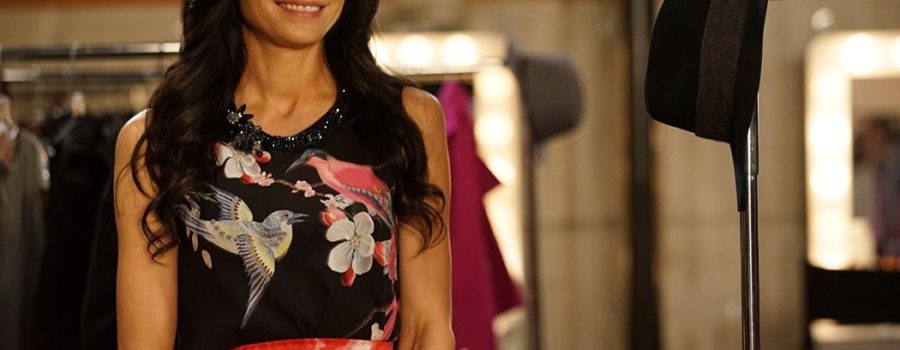[Published at Film Inquiry] Sharon Stone’s latest film, All I Wish, starts off very casual, and, unfortunately, doesn’t gain any steam from there. It offers a minimally interesting story, but serves up some fine leads and performances from Stone, Ellen Burstyn, Liza Lapira, Tony Goldwyn, and Gilles Marini. However, are the characters exactly full-dimensional? For the primary characters, yes. Not all of the secondary characters hold their own within the context of the entire story, but that may partially be the case because of the nature of the story, I suppose.
Susan Walters’ story is laudably unique. The longtime second unit director, who also makes her directorial debut with All I Wish, only shows us our central character, Senna Berges (Stone), once a year on her birthday. In between birthdays, there are, at times, poignant little segments with various characters reminiscing about their past. What results is a meandering, occasionally somewhat engaging story about a struggling fashion designer.
A Series Of Vignettes
Every time I think of the phrase, “series of vignettes,” I think of the film Two For The Road as my precedent. If the the film is intending to be like a series of moments in a person’s life with time jumps? Or is is a linear story. If it is the former, then I see how close it is to Two For The Road, whose editing is flawless. In All I Wish‘s case, the editing and overall structure is similar to that of in Groundhog Day.
Pembroke J. Herring’s editing of Groundhog Day was fantastic, but he wouldn’t necessarily take the same approach if it the plot was that of All I Wish’s, one day out of one year progressed, instead of one day on repeat. Every birthday starts out the same. Aside from Walters using different shots and camera angles, the scene is the same. Different angles can’t save the stop-go editing; if only it had more fluid transitions. If only the talented Famke Janssen wasn’t so underutilized and reduced to only a few lines.
What is great about these scenes, however, is that they show Stone’s range as an actor. We all wake up in a slightly different mood, depending on how we feel on a given day. Some days we might be happy. Some days we may feel down. Some days we may feel upset. You get the point. We’ve all be there. Stone is all of those things in All I Wish, portraying everything from depressed to ecstatic. It’s a pleasure to see.

source: Paladin
Ellen Burstyn is a national treasure. The Oscar winner as Celia, Senna’s mother, is a privilege to watch. When All I Wish focuses on the scenes between her and Stone, the film is at its best. These two acting heavyweights interacting is so effortlessly nuanced and skilled, it’s intimidating. The scenes between Stone and Goldwyn aren’t too shabby, either; nothing feels forced between them.
Where Is This Story Going, Again?
As I mentioned, the plot meanders, and it does so in a rather nonchalant manner. It doesn’t seem to care if it engages the viewer or not. It’s all too predictable. We have a pretty idea of what’s going to happen. Girl is struggling to accomplish her dreams, can’t meet boy. Girl meets boy once a year on her birthday. Something develops. However, it takes a while for the story to get to its major hurdles, and for it to maintain the momentum it gets after each of Senna’s birthdays. And surely, Walters could have come up with better segment titles than “Next Birthday.”

source: Paladin
Perhaps it is just the nature of the structure of visiting and revisiting characters once a year. The audience misses out on the moments and the moments in between moments, the fights, the makeups, the ups and downs. There is only so much conflict that can be portrayed, one birthday at a time. Walters limits herself, in that sense, narratively, but her plot is still an ambitious concept.
Tonally Uneven, But Not All Bad
Because of the birthday-only, recurring, day-in-the life structure of All I Wish, the tonal shifts can be clunky and uneven, at times, and emotions intended to hit the audience hit hard, as evidenced by the score’s familiar touching string serenade, seem forced. Things like arguments seem almost hilariously out of place. However, beneath its flaws, All I Wish has some inspiring messages in it that will resonate with a lot of viewers. The performances are honest and primarily effective.

source: Paladin
It’s nice seeing Stone back in a starring role again, and she hasn’t lost her ability to carry a film. Along with the aforementioned Burstyn, Lapira as Stone’s Senna’s friend Darla gives a particularly strong performance, giving a raw, emotional performance. Chris Horvath’s score is a by-the-numbers romantic comedy work, as is much of All I wish.
All I Wish: Not A Great 94 Minutes
Horvath’s score is, at times, excessively kitsch, although it’s quite the throwback playing the “sexy” jazz alto saxophone during a sex scene. Mona May’s costume design is great, Walters‘ direction is assured and steady-handed, and she directs All I Wish with skill that provides enough proof that the first-time director has a bright future in the industry. One thing is for sure, it’s nice to see more romantic comedies getting made by women, from a woman’s perspective.
However, All I Wish, despite boasting a strong cast and performances, fails to deliver the goods. Its Graduate-esque ending is emblematic of the movie itself, clichéd and tawdry.
In your opinion, did All I Wish suffice as a watchable rom com? Do you think it will earn Walters more work on features? What was your favorite moment in the film?
All I Wish will be released by Paladin theatrically and via VOD on March 30, 2018. For more information on its release, click here.
“The clock has run out on sexual assault, harassment and inequality in the workplace. It’s time to do something about it.” Read the Letter of Solidarity here. Make a donation to the legal fund here.








Leave a Reply
Your email is safe with us.